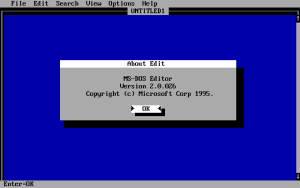MS-DOS Editor
MS-DOS Editor, commonly just called edit or edit.com, is a character-based text editor that comes with MS-DOS (since version 5)[1] and 32-bit versions of Microsoft Windows.[2] It superseded edlin, the standard editor in earlier versions.
 The MS-DOS Editor interface | |
| Developer(s) | Microsoft Corporation |
|---|---|
| Initial release | June 1991 |
| Stable release | 2.0.026
/ 1995 |
| Operating system | MS-DOS, PC DOS, OS/2, Microsoft Windows |
| Type | Text editor |
| License | MS-DOS, PC DOS, OS/2, Windows: Proprietary commercial software |
| Website | docs |
Until MS-DOS 6.22 it was actually QBasic running in editor mode, but from DOS 7 (Windows 95) QBasic was removed and MS-DOS Editor became a standalone program.
Editor is sometimes used as a substitute for Notepad on Windows 9x, where Notepad is limited to small files only. Editor can edit files that are up to 65,279 lines and up to approximately 5 MB in size. MS-DOS versions are limited to approximately 300 kB, depending on how much conventional memory is free.[3] Editor can be launched by typing it into the Run command dialog on Windows, and by typing edit into the command-line interface. Edit is still included in later versions of Windows such as Windows XP, Windows Vista 32 bit, Windows 7 32 bit, and Windows 8 32 bit. Being a 16-bit DOS application, it will not directly run on 64-bit Windows versions.
Versions
Edit version 1.0 appeared in MS-DOS / IBM PC DOS 5.00, OS/2, and Windows NT to 4.0. Early Chicago betas included this version too. These editors rely on QBasic 1.0. This version can only open one file, to the limit of DOS memory. Although this editor can open one file, it can also open the quick help file in a split window.
Edit version 1.1 appeared in MS-DOS 6.0. No new features were added to the editor: the main difference is that the QBasic 1.1 is used to show the MS-DOS 6.0 help. This version is available also on all versions of Windows 9x, although the files are unchanged from 6.22. Renaming help.hlp to edit.hlp allows one to access the DOS 6 help system inside the editor, including cut and paste between the help system and the open file.
PC DOS 6 does not include the edit command. Instead, it has the DOS E Editor. This was upgraded to support mouse and menus in version of 7.0.
Edit version 2.0 appeared with Windows 95, and appears in Windows 2000 and later, now not using QBasic. As it is still a 16-bit DOS program, it is not included in any 64-bit version of Windows, nor will it directly work on one. This version of Edit will run on DOS 3.30 and higher and requires an 80286 or NEC V20/V30 processor or higher. (When run on an 8088 or 8086 processor it will cause the system to stop responding.)
The FreeDOS version was developed by Shaun Raven and is licensed under the GPL.[4]
Features
MS-DOS Editor uses a text user interface and its color scheme can be adjusted. It has a multiple document interface in which its version 2.0 (as included in DOS 7 or Windows 9x) can open up to 9 files at a time while earlier versions (included in DOS 5 and 6) are limited to only one file. The screen can be split vertically into two panes which can be used to view two files simultaneously or different parts of the same file. It can also open files in binary mode, where a fixed number of characters are displayed per line, with newlines treated like any other character. This mode shows characters as hexadecimal characters (0-9 and A-F). Editor converts Unix newlines to DOS newlines and has mouse support. Some of these features were added only in 1995 (version 2.0), with the release of Windows 95.
References
- Wolverton, Van (2003). Running MS-DOS Version 6.22 (20th Anniversary Edition), 6th Revised edition. Microsoft Press. ISBN 0-7356-1812-7.
- MS-DOS and Windows command line edit command
- "Largest Document Size MS-DOS Editor Can Edit". 2003-05-12. Archived from the original on 2012-10-22. Retrieved 2008-06-12.
- http://www.ibiblio.org/pub/micro/pc-stuff/freedos/files/distributions/1.2/repos/pkg-html/edit.html
Further reading
- Cooper, Jim (2001). Special Edition Using MS-DOS 6.22, Third Edition. Que Publishing. ISBN 978-0789725738.
- Tim O'Reilly; Troy Mott; Walter Glenn (1999). Windows 98 in a Nutshell: A Desktop Quick Reference. O'Reilly. ISBN 978-1565924864.
External links
| Wikibooks has a book on the topic of: Guide to Windows Commands |